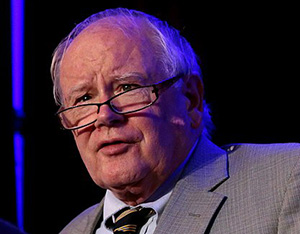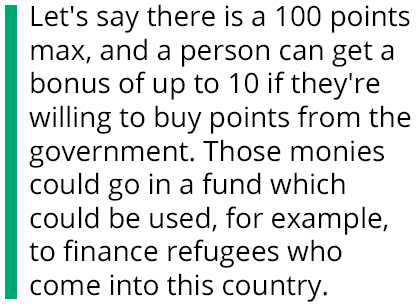 For our third Strategic Inquiry, Ideaspace talked to a range of experts about their take on the possibility of implementing a point-based immigration system. One of the experts we talked to is Dr. Richard Vedder, who has been studying immigration from an economic point of view for more than 40 years. He brings years of research comparing market-driven immigration with other models including point-based selection systems. In addition to his professorship of economics at Ohio University, he’s worked on congressional committees and been associated with various think tanks over the years. Currently he is an advisory board member for the National Foundation for American Policy.
For our third Strategic Inquiry, Ideaspace talked to a range of experts about their take on the possibility of implementing a point-based immigration system. One of the experts we talked to is Dr. Richard Vedder, who has been studying immigration from an economic point of view for more than 40 years. He brings years of research comparing market-driven immigration with other models including point-based selection systems. In addition to his professorship of economics at Ohio University, he’s worked on congressional committees and been associated with various think tanks over the years. Currently he is an advisory board member for the National Foundation for American Policy.
We began the conversation by asking Dr. Vedder to give us his general thoughts on the possibility and wisdom of implementing a point-based immigration system in the U.S.
Below, our full interview with Vedder, which has been lightly edited for clarity.
 Richard Vedder: I start out with the premise that I think immigration is by and large a good thing and it is useful for nations to have immigration and a fairly substantial amount of it. And because of various political problems and cultural problems associated with immigration, there are almost certainly going to be limits placed on it, and so the question then becomes, how do you limit it? And I think the point-based system has some merit in it. I would prefer a world with a point-based immigration system to a world where decisions are made based on previous family connections to the United States, which is, of course, a large part of what immigration policy has been in the U.S. over the last half century.
Richard Vedder: I start out with the premise that I think immigration is by and large a good thing and it is useful for nations to have immigration and a fairly substantial amount of it. And because of various political problems and cultural problems associated with immigration, there are almost certainly going to be limits placed on it, and so the question then becomes, how do you limit it? And I think the point-based system has some merit in it. I would prefer a world with a point-based immigration system to a world where decisions are made based on previous family connections to the United States, which is, of course, a large part of what immigration policy has been in the U.S. over the last half century.
I think a point-based system has the potential of improving on existing law. But there are some problems with point systems and I might probably go to a pure market-based system, where we literally allow in the people who want it the most, and allow them to buy their way in by paying more money for a visa, entrance visa, or an opportunity to ultimately get a green card or citizenship. If you’re willing to pay for it, let them in. If you’re not willing to pay for it, don’t let them in. And as I’ve discussed in some of my writings, yes, there are some arguments against that, but I think it is a relatively fair, objective system and I think on average, it would bring in higher, more productive immigrants than we would get otherwise, and thus would have some positive spillover effects on the general American population.
Part of the reason I favor a market-based approach is a political argument. Americans are skeptical about immigration to varying degrees. Some less so than others. Some are fanatically opposed to it. So there are variations in people’s attitudes, but you could, in effect, raise a fair amount of money through immigration. As I have argued, you can literally, if you wanted to, use those funds to lower taxes on the existing population, say income taxes, by giving everyone say a 2- or 3- or 4-percent rebate on their income tax, or a reduction in their income tax, and they would be told that this tax reduction comes as a consequence of immigration to the United States.
If that were to happen, it might soften opposition to immigration and increase awareness on the part of the native-born population that immigrants can, in fact, have a positive impact. They do have a positive impact, by the way, but some of the gains from immigration are sort of hidden and subtle. This would be a very unsubtle, a very direct way of increasing public support. Having said that however, a Canadian-style point system, maybe with some modification, is another way of doing it, and I prefer it to what we have now.
But as I’ve pointed out there are some problems with a point system, because if you set up a rigid system for getting so many points for this attribute or characteristic of an immigrant, and so many points for another attribute and so forth, and those are fixed in number and there’s no administrative discretion in awarding those points, you could get a situation where the system is overly rigid and we get results that are not optimal.
For example, is an engineering degree from MIT, or a crackerjack Swiss school or Oxford or Cambridge, worth more than a Bachelor’s degree from a school of dubious accreditation? Or a Bachelor’s degree in sociology from some mid European university that has very little reputation? There are people who you say we’re going to give more to the people in the STEM disciplines. Well, in the United States, there is a high demand for certain types of STEM occupations relative to other science technologies. The biological sciences, actually, some of them have relatively high unemployment, extremely high unemployment because there seems to be, relatively speaking, a surplus of workers in some of those scientific fields, relative to other fields — compared to computer science or engineering fields, for example.
So, for that reason, the point system to me is a second-best solution, but sometimes in the real world we work with second-best solutions, because the first-best solutions are for one reason or other, unpalatable to a significant subset of our population, and are politically impossible. So, it wouldn’t be the first time in public policy that we did something that wasn’t exactly optimal, but which is still an improvement over what we have now.
Ideaspace: I know that some of the countries that have more successful point systems — Canada, for example — have a parliamentary system that makes it possible to routinely adjust point values. Do you think that there’s a model we could pursue in the U.S. where we would have an agency independent of Congress that could revisit point values on an annual or biannual basis?
RV: That is an important question. And one where, again, the way you answer it does depend on institutional arrangements such as a form of government support, and do you give administrators — let’s call them bureaucrats, paid government officials — discretion, which is to say they can modify the points, maybe not only every two years, but annually.
But if you give them a lot of discretion, then our immigration laws are being determined by administrators, by the administrative state as it were, rather than by the normal democratic process. And there’s some risk there, too. And it isn’t quite like I’m thinking the old Soviet Union where you had the police state, who scared the hell out of people and had all sorts of discretion to do whatever they want and this really wreaked havoc in people’s lives. I don’t really see a situation like that developing, but you don’t know and you might have certain public interest, certain groups promoting special, “We should give extra points for this or that.”
So, I would agree that, if we went to a point system, reassessing the points every so often would be advisable. The question is, who does the reassessment? In a democracy you want a policy to be the will of the people, roughly. Do you turn this over to unelected technicians or bureaucrats in some government agency, or do you turn it over to academics who have, say labor market specialists and so forth? How do you avoid a special interest group pleading in a way that distorts the system? And so there’s some concern there.
That’s the beauty of my market system: a dollar is a dollar is a dollar. And if you have to pay $20,000 to get a visa, you pay $20,000 to get a visa and it’s a relatively low hassle system. The amount you pay for a visa literally could change every day, or even every hour. And you take all the bureaucratic hassle out of it.
I: You mentioned the possibility of looking at evaluating point values in real time, and that was an interesting notion to me. And it made me immediately think about the Fed. The Fed is this independent body that monitors monetary policy and is a voting body and we give it necessary independence from our branches of government. Is that a model that we could consider in very broad strokes?
RV: Well, I think you’re onto something. It’s a possibility. As I said, the beauty of the market approach is you’re not relying on experts, you’re relying on the whole population. The whole economy in effect, to make that decision. But, yeah, you could do that and you could maybe do like the Fed. The Fed has had a rules approach. For example right now it is a Fed rule of thumb that we want inflation in the United States not to exceed 2 percent a year, but not to be much less than 2 percent a year either. So that’s the current rule of thumb that the Fed is following right now. It’s no law, Congress never passed it, it was something the Federal Reserve Board of Governors or the Open Market Committee of the Fed, decided.
 We could have similar rules of thumb, I suppose, for an independent body on immigration. For example, if the unemployment rate rises above 7 or 8 percent, we will reduce the number of people admitted under a point system or market-based system or whatever by 25 or 50 percent, we’ll limit the numbers to X. And yet if the unemployment rate falls below 4 percent, we’ll let it go up. You could have a rule about how many immigrants you admit for each 1-percent fall in the employment rate or something — I’m just giving you an example. So you could have a rules approach giving a body some discretion but constrain them somewhat by rules.
We could have similar rules of thumb, I suppose, for an independent body on immigration. For example, if the unemployment rate rises above 7 or 8 percent, we will reduce the number of people admitted under a point system or market-based system or whatever by 25 or 50 percent, we’ll limit the numbers to X. And yet if the unemployment rate falls below 4 percent, we’ll let it go up. You could have a rule about how many immigrants you admit for each 1-percent fall in the employment rate or something — I’m just giving you an example. So you could have a rules approach giving a body some discretion but constrain them somewhat by rules.
If you have a point system, and you turn it over to an independent body you can make it bipartisan or nonpartisan. Another model is the model we follow with various government regulatory agencies with three Republicans and three Democrats and one Independent on the board, or that the chair of the board will be selected by the President with the approval of the Senate, but the other six members will be appointed in some way, either by the President of the United States or by Congress. It would be fine with me. It would be an interesting approach.
I: Ideaspace’s primary goal is to identify points of consensus and we’re looking at the point system, because, while it’s been very popular on the right — former President Trump likes it very much and I know a lot of immigrant restrictionists like it because there are models that could accomplish reductions in immigration. But I’ve seen models on the left, too, which are designed to increase immigration.
RV: That’s right. I don’t think a point system is inherently right wing or inherently left wing. And when it comes to immigration policy, I’m not sure I know what “right wing” or “left wing” is. I used to work for Congress. I worked for the Joint Economic Committee of Congress in the early ’80s. I probably testified dozens of times before various committees of Congress on all sorts of subjects. So I actually knew the characters, personally. People like Representative Dick Armey, who was House Majority Leader for the Republicans. He was, is and always will be something of a libertarian-orientated person, who believes in free immigration. And yet he’s on the right.
I also knew Austrian economists, who are the ultra-right types, including the late Murray Rothbard. These are really hardcore right wing people, who in the ’80s and ’90s turned against immigration. Some of them were historically in favor of it but they decided let’s look at the nation as a private club. People who were in a private club should be able to decide who are its members and maybe if the nation as a whole or members of this club decide they don’t want new immigrants coming in, they should have the right to say so and do so.
So there are people all over the spectrum, same on the left, with respect to this. And the tempers change over time, if you look at immigration policy.
I: Some major swings, you’re right. Look at the George W. Bush years and see what he was trying to do with moving immigration forward and there was pushback within his own party, that right there tells you there aren’t really clear lines or stereotypical lines.
RV: Oh absolutely. I briefly worked for the Bush Institute after Bush left office. I did a little work on immigration, pro-immigration matters, and was pushing things like a point system or a market-based system. But at the same time, within the Republican Party, you had people who were strongly on the other side. Labor unions have gone both ways on this, too, mostly historically skeptical of immigration, opposing immigration and so forth, but in some modern periods, they have been very pro immigrant labor.
I: Yeah. I actually think that when you talk about labor, that’s one other place where you could find glimmers of consensus because consider the possibility of better enforcement of labor laws. That lifts all ships — anyone working in the U.S. I’m thinking of your idea to generate tax revenue with the visa fee: perhaps a small portion of that could go towards more personnel to enforce labor laws so that labor unions and the American workers, all workers, feel like they’re better protected. Again, just trying to seek consensus.
Speaking of your idea about a market-driven visa fee system, I know you write about low-wage workers as well. How might fees apply to low-wage workers? You mention the possibility of bringing agricultural workers over for a few months at a time. In your model, would that exist outside the fee system?
RV: You could have temporary work permit type visas for three months, six months, which might be renewable in future years. In other words, one archetypal example [is] an agricultural worker from Mexico or Central America, coming into a western state and the person could come for four to six months a year for 20 years in a row and still maintain permanent residency in, I’ll use Mexico as an example, and come in and their visa is good for four months. If they’re caught in the country after the four months, they’re subject to the penalties that go with illegal immigration into the Unites States. So you could buy your way in for a short period and it may even be that agricultural, the farms and agricultural producers of large size, might buy up several of these visas themselves and distribute them to their workers who apply from, say, Mexico. It could also maybe be subject to penalties if the worker is overstaying. You could put bonds in and so forth. There are various ways you could enforce it.
I: When you talk to people in, say, the San Diego-Tijuana region, where you’ve had most of the unauthorized crossings before border barriers started going up, a lot of agricultural workers in the ’60s, ’70s and ’80s would go back and forth every year, doing what you’re suggesting, only informally. But it became too difficult to cross back and forth when walls were put up and more security was put in place.
RV: The growing season is every six months, three months, maybe it’s 30 days. I remember way back in my youth immigrants coming up from Mexico all the way into northern Michigan to pick cherries for a month and then they disappeared. So the season could vary in length. In some cases it would be just picking a crop and in some cases it would be growing a crop, engaging in a full-fledged farm operation over a period of multiple months. But it’s still a fraction of the year. There’s several months a year where it would not be applicable, where you simply can’t farm.
I would think for a lot of agricultural workers, this would be a fairly decent deal. They make a lot more money in the U.S. than they would in their home country. As it is now, they’re being divided from family, which is one of the costs of immigration for single people who come. That cost would be mitigated considerably because you could be with your family for a good part of the year.
I: The idea of the visa fee, I had to admit, when I first saw that, it leapt out at me as some great impossibility in terms of the dollar amount for migrants moving about the world doing some of these lower wage jobs. But you point out in one of your papers that so often migrants pay similar fees to smugglers.
RV: How the hell they come up with $20,000 bucks or whatever the amount might be? What you’re seeing people do now to help finance college is something called income share agreements. In other words, “I’ll pay for your visa into the United States, if you will give me X percentage of your income for the next three years or the next five years.”
Companies could do this. Take, for instance, a computer programmer or something, who would come from, say, India and normally get $60,000 a year. The American company could say, “Look, we’ll give you $55,000 a year, but you have to agree to stay with us for three years or four years or whatever, but we’ll buy your visa for you, which will cost $15 or $20,000.”
 I think, particularly for high-skilled people, I don’t think the cost of the visa would be too great. I think there would be ways that it could be financed and some financial institutions who love to make money, they might jump into this market too. That I think would be a possibility.
I think, particularly for high-skilled people, I don’t think the cost of the visa would be too great. I think there would be ways that it could be financed and some financial institutions who love to make money, they might jump into this market too. That I think would be a possibility.
I: It seems to me that there’s a place where a market-driven system could, in fact, meet a point system.
RV: I think you can integrate both of these. It might be you could have a point system where a person could buy some points in addition to the points that are administered based on characteristics of the individual, education, previous employment, age, whatever, that are used in determining the points. Let’s say there is a 100 points max, and a person can get a bonus of up to 10 if they’re willing to buy points from the government. Those monies could go in a fund which could be used, for example, to finance refugees who come into this country.
In other words, it could be used in a pro-immigration way. And there is a possibility you could have an integrated point system, market-based system. It’s doable.
Read More:

Ideaspace Interview No. 5

Strategic Inquiry No. 2



